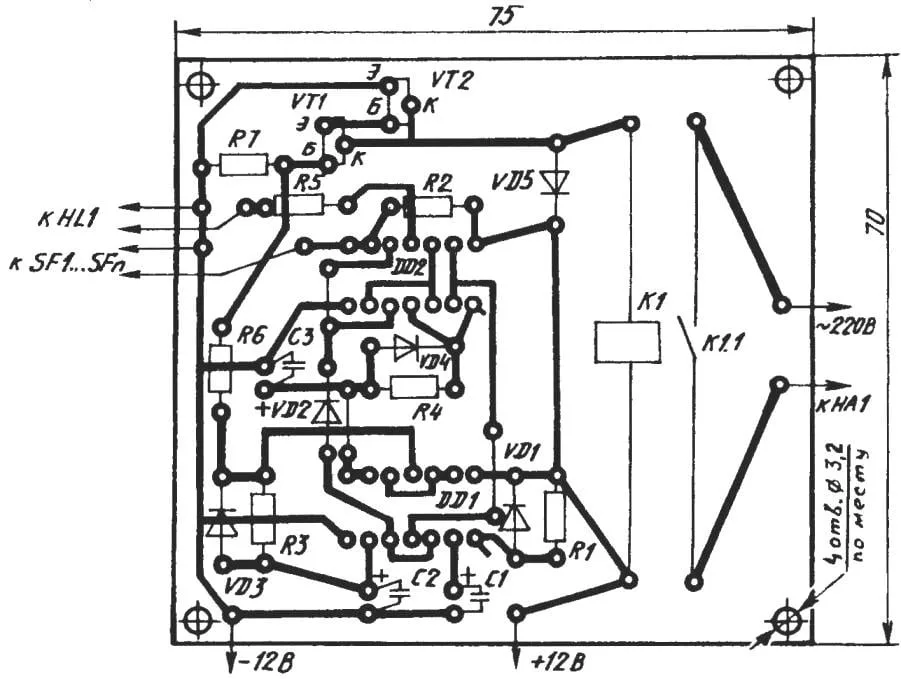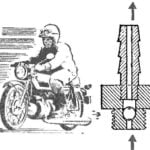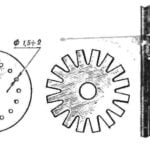 This is a safety alarm device (SLD) is designed to automatically alarm (electrozone) in the case of penetration of unauthorized persons in the protected object — an apartment, dacha, garage. It is more immunity and no false positives. The unit is powered by 12-volt battery GB1 of the eight cells that consume standby current less than 5 mA.
This is a safety alarm device (SLD) is designed to automatically alarm (electrozone) in the case of penetration of unauthorized persons in the protected object — an apartment, dacha, garage. It is more immunity and no false positives. The unit is powered by 12-volt battery GB1 of the eight cells that consume standby current less than 5 mA.
Part of the SLD consists of three Comparators. First assembled on the logic element DD1.1 with the capacitor C1, resistor R1 and diode VD1; the second — on DD1.2 with the capacitor C2, resistor R3 and diode VDЗ; and the third on DD1.3 with capacitor C3, resistor R4 and diode VD4. Other components of the device: inverters (DD1.4 and DD2.1), RS trigger on the elements DD2.2 and DD2.3, the display unit switch the device on and enter standby mode (DD2.4 with the resistor R5 and the led HL1), transistor current amplifier (VT1 and VT2 with a load in the form of electromagnetic relay K1, the contact K1.1 which includes call HA1, an alarm is triggered when unauthorized entry to the protected object).
In preparing the device for work (before leaving room) close contacts of door sensors SF1 — SFN of the alarm loop. Then turn on the switch SA1, the feeding to the circuit voltage. When this appears in the log.0 (logical “zero”) at the entrance of the element DD2.1, and the output, respectively, of the log. 1 (logical “unit”). The latter is applied to the input 5 DD2.2.
Through a resistor R1 for 50-70 C is the charge of the capacitor C1. At this time, the output of the element DD1.1 is high. 1, and at the conclusion of 4 DD1.2 — low voltage, which is fed to the input 2 of the element DD2.3. Then, RS-flip-flop is in a zero condition, characterized by the fact that at pin 4 of the chip DD2 will log.0, and at terminal 3 — voltage high level. It affects input 12 DD2.4. But at the entrance 13 of the same logical element is present low voltage, resulting in a conclusion of 11 DD2.4 set log. 1, lighting led HL1, indicating the device is switched on.
While the input 2 of the logic element DD2.3, tension is low-level, short-term disconnection of contacts of the sensors SF1 — SFN does not alter the state of the trigger. At this time, called setup, you can freely leave the premises.
When the capacitor C1 is charged, the log.1 at the conclusion of 3 DD1 will change to the log.0, and at terminal 4 of the chip will set the voltage high level, which is fed to the input 2 logic element DD2.3. The state of the RS-flip-flop will remain unchanged.
Simultaneously, the voltage received from the output element DD1.2 input 13 DD2.4, with the result that at the output 11 of the chip DD2 is the log. 1 will log.0. HL1 led turns off, this means that the SLD switched to the standby mode.
Now, any unauthorized attempts to enter the room will trigger (termination of contact) one of the sensors SF—SFN security loop. The effect of this will flow through resistor R2 to the input of logic element DD2.1 voltage of high level. Then at pin 10 of the chip DD2 will log.0, which, via the input 5 logic element DD2.2 change the state of the flipflop to the opposite. In this case, the terminal 4 DD2 will have a voltage of high level. It will charge the capacitor C3 in the period of 30 to 50 C.

A circuit diagram and a printed circuit Board, a homemade device alarm
While C3 is charging, the comparator output DD1.3, tension is high level, and the output of the inverter DD1.4 — log.0. But then the state of this node will change. The capacitor is charged, and the voltage acting on the input of the comparator DD1.3 ensure the appearance of a log.0 at pin 10 of the microcircuit DD1.
Thus the output of the inverter DD1.4 will log.0, which, via the resistor R6 will arrive at the base of a semiconductor triode VT1, and that, opened, opens, and transistor VT2. The result of the work of the electromagnetic relay K1 and its contacts K1.1 include call HA1.
But to make it so that the alarm is sounded (for example, when checking the protected premises or when it is the owner). For this purpose, the SLD-off toggle switch SA1 at the time of charging of the capacitor C3, which is, as noted above, 30-50 C.
If the contact sensors SF1— SFN of the security loop is again closed and the switch SA1 remains in the on position, the voltage present at the output element DD1.4, will charge the capacitor C2. Approximately 70-90 with will log.1 on input 6 DD1.2, and the output voltage of a low level. It will switch the trigger in the zero state, in which the exit 4 of element DD2.2 will log.0. Then, the SLD will again go into a standby mode of protection of object.
The “filling” of the burglar alarm device mounted on a printed circuit Board 1.5 mm foil getinaks. It is recommended to use fixed resistors MLT-0,125, and the capacitors C50-35, IC К561ЛЕ5 (DD1) and K561LA7 (DD2), semiconductor diodes КД103А, kt315g transistors, led АЛ307АМ, relay RPG-5-2101-UZ-12V, toggle switch MT-1, R20 battery cells. For the door sensors security Flex cable fit model SMK-1, for window — DIMK. As the alarm signaling will fit the loud call of the battle of MZ-2 (220 V, 50 Hz).
Possible and replacement. Instead of transistors КТ315Г acceptable to their counterparts with any alphabetic index in the name. The same in respect of diodes and LEDs. RPG-5-2101 -UZ-12V can replace the electromagnetic switch with a trigger voltage of 10 V, the contacts of which is designed for a current of 0.1 A at 220 V. With the same function call can handle electromagnetic Howler RV4-2 (220 V, 50 Hz).
If the installation is correct and undamaged parts, the debug operation is not needed. If you want you can change the temporal characteristics of the SLD with appropriate selection of timing resistors or capacitors in the RC-circuits.
G. SKOBELEV, Kurgan



